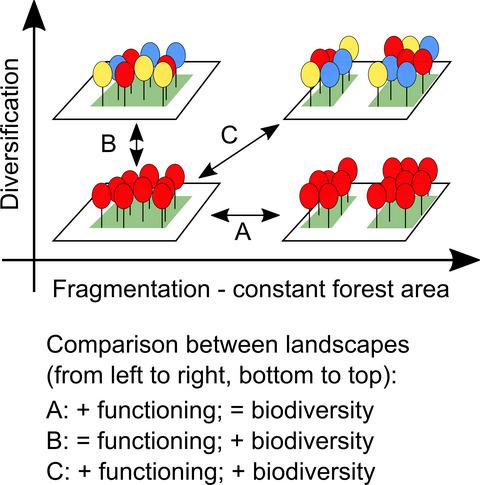当前位置:
X-MOL 学术
›
J. Appl. Ecol.
›
论文详情
Our official English website, www.x-mol.net, welcomes your
feedback! (Note: you will need to create a separate account there.)
Mixing of tree species is especially beneficial for biodiversity in fragmented landscapes, without compromising forest functioning
Journal of Applied Ecology ( IF 5.0 ) Pub Date : 2021-09-03 , DOI: 10.1111/1365-2664.14013 Lionel R. Hertzog 1, 2 , Martijn L. Vandegehuchte 1, 3 , Daan Dekeukeleire 1 , Wouter Dekoninck 4 , Pallieter de Smedt 5 , Irene van Schrojenstein Lantman 1 , Willem Proesmans 5 , Lander Baeten 5 , Dries Bonte 1 , An Martel 6 , Kris Verheyen 5 , Luc Lens 1
中文翻译:

在不影响森林功能的情况下,混合树种特别有利于分散景观中的生物多样性
更新日期:2021-09-03
Journal of Applied Ecology ( IF 5.0 ) Pub Date : 2021-09-03 , DOI: 10.1111/1365-2664.14013 Lionel R. Hertzog 1, 2 , Martijn L. Vandegehuchte 1, 3 , Daan Dekeukeleire 1 , Wouter Dekoninck 4 , Pallieter de Smedt 5 , Irene van Schrojenstein Lantman 1 , Willem Proesmans 5 , Lander Baeten 5 , Dries Bonte 1 , An Martel 6 , Kris Verheyen 5 , Luc Lens 1
Affiliation

|
- Contemporary forest management strives to satisfy contrasting demands on forest ecosystems by promoting multiple ecosystem services. These services are affected in varied manners by alternative management actions operating at local or landscape scales, potentially leading to trade-offs and synergies that may impede or encourage forest managers to change practices.
- We here studied ecosystem functions and biodiversity across trophic levels in 53 mature forest plots varying in stand-level (tree species composition) and landscape-level (degree of fragmentation) characteristics. The consequences of tree species composition and forest fragmentation for the provision of forest ecosystem services were explored using desirability scores, contrasting two different perspectives on forest management: a conservationist perspective placing more value on biodiversity conservation and a productivist perspective attaching more value to timber production and natural forest regeneration. These scores were derived at two spatial scales distinguishing between ecosystem functions and forest biodiversity.
- We show that more than two thirds of the 20 trade-offs and synergies between functions and diversity variables were driven by variation in tree species composition and fragmentation. While multifunctionality depended on the forest management perspective at the stand level, this dependence was no longer apparent at the landscape scale. Interestingly, more strongly fragmented landscapes had higher landscape-level multifunctionality, but this came at the expense of biodiversity across trophic levels. At the same time, mixed forest stands had higher levels of biodiversity than monocultures without affecting multifunctionality.
- Synthesis and applications. In monocultures, it depends on the management perspective as to which tree species best maximizes multifunctionality. However, diversifying stands resolves this potential tension between different perspectives; in mixtures the level of multifunctionality no longer depended on the management perspective and similar levels were reached compared to the monocultures. Tree species mixtures also maximized biodiversity across trophic levels. Diversifying forest stands thus represents a promising management strategy that resolves potential trade-offs between functioning and biodiversity.
中文翻译:

在不影响森林功能的情况下,混合树种特别有利于分散景观中的生物多样性
- 当代森林管理努力通过促进多种生态系统服务来满足对森林生态系统的不同需求。这些服务以不同的方式受到在当地或景观范围内运作的替代管理行动的影响,可能导致可能阻碍或鼓励森林管理者改变做法的权衡和协同作用。
- 我们在此研究了 53 个不同林分(树种组成)和景观水平(破碎度)特征的成熟森林地块中不同营养级的生态系统功能和生物多样性。使用意愿评分探讨了树种组成和森林破碎化对提供森林生态系统服务的影响,对比了森林管理的两种不同观点:保护主义观点更重视生物多样性保护,生产主义观点更重视木材生产和天然林再生。这些分数是在区分生态系统功能和森林生物多样性的两个空间尺度上得出的。
- 我们表明,功能和多样性变量之间的 20 个权衡和协同作用中有三分之二以上是由树种组成和碎片化的变化驱动的。虽然多功能性取决于林分层面的森林管理观点,但这种依赖性在景观尺度上不再明显。有趣的是,更强烈的碎片化景观具有更高的景观水平多功能性,但这是以牺牲跨营养级的生物多样性为代价的。同时,混交林分的生物多样性水平高于单一林分,而不会影响多功能性。
- 合成与应用。在单一栽培中,哪种树种最能最大限度地发挥多功能性取决于管理观点。然而,多样化的展位解决了不同观点之间的潜在紧张关系;在混合物中,多功能水平不再取决于管理观点,与单一栽培相比达到了相似的水平。树种混合物还最大限度地提高了整个营养级的生物多样性。因此,林分多样化代表了解决功能和生物多样性之间潜在权衡的有前途的管理战略。









































 京公网安备 11010802027423号
京公网安备 11010802027423号